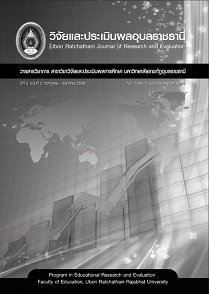การสร้างและพัฒนาเครื่องมือวัดความสามารถด้านมิติสัมพันธ์ของเด็กปฐมวัย 48-55
บทคัดย่อ
การวิจัยครั้งนี้มีวัตถุประสงค์เพื่อสร้างและหาคุณภาพเครื่องมือวัดความสามารถด้านมิติสัมพันธ์ของเด็กปฐมวัย และสร้างเกณฑ์ปกติ ตัวอย่างที่ใช้ในการวิจัยครั้งนี้เป็นนักเรียนชั้นอนุบาลปีที่ 2 โรงเรียนในสังกัดสำนักงานเขตพื้นที่การศึกษาประถมศึกษาอุบลราชธานีเขต 2 จำนวน 341 คนได้มาด้วยการสุ่มแบบหลายขั้นตอน เครื่องมือที่ใช้ในการวิจัยเป็นแบบวัดเชิงรูปภาพ มี 3 ตัวเลือก จำนวน 5 ฉบับ รวม 25 ข้อ ประกอบด้วย ด้านความเหมือนความต่าง ด้านการต่อเข้าด้วยกัน ด้านการแยกออกจากกัน ด้านตำแหน่งของสิ่งต่าง ๆ ที่สัมพันธ์กัน และด้านความสัมพันธ์ของวัตถุสิ่งของกับทิศทาง สถิติที่ใช้ในการวิเคราะห์ข้อมูล ได้แก่ ค่าเฉลี่ย ส่วนเบี่ยงเบนมาตรฐาน ค่าความยาก ค่าอำนาจจำแนก ค่าความเที่ยงตรงเชิงเนื้อหา ความเที่ยงตรงเชิงโครงสร้าง และค่าความเชื่อมั่น
ผลการวิจัยพบว่า
- 1. แบบวัดความสามารถด้านมิติสัมพันธ์ ทั้ง 5 ฉบับ มีค่าเฉลี่ย เท่ากับ 89 ส่วนเบี่ยงเบนมาตรฐาน 7.65 ความเชื่อมั่นทั้งฉบับ 0.95 ค่าความยากตั้งแต่ 0.39 ถึง 0.80 ค่าอำนาจจำแนกตั้งแต่ 0.39 ถึง 0.99 และ
ความเที่ยงตรงเชิงโครงสร้าง มีค่า Eigen Values ตั้งแต่ 0.608 ถึง 0.907 ความเที่ยงตรงเชิงเนื้อหามีค่าความสอดคล้องตั้งแต่ 0.80 ถึง 1.00 - 2. เกณฑ์ปกติของแบบวัดความสามารถด้านมิติสัมพันธ์ทั้ง 5 ฉบับ มีช่วงคะแนน T ปกติอยู่ระหว่างคะแนนตั้งแต่ T30 – T70
เอกสารอ้างอิง
คันธรส วงศ์ศักดิ์. ความสามารถด้านมิติสัมพันธ์ของเด็กปฐมวัยที่ได้รับการจัดกิจกรรม ศิลปะประดิษฐ์โดยใช้พืชผักผลไม้. ปริญญานิพนธ์การศึกษามหาบัณฑิต มหาวิทยาลัยศรีนครินทรวิโรฒ, 2553.
เชาวน์ประภา เชื้อสาธุชน. เอกสารการสอนวิชาการพัฒนาเครื่องมือในการวิจัยและประเมินผลการศึกษา. อุบลราชธานี: มหาวิทยาลัยราชภัฏอุบลราชธานี, 2546.
ธีรวุฒิ เอกะกุล. ระเบียบวิธีวิจัยทางพฤติกรรมศาสตร์และสังคมศาสตร์. พิมพ์ครั้งที่ 6. อุบลราชธานี:
วิทยาออฟเซทการพิมพ์, 2552.
นัฐภรณ์ แตงอ่อน. การพัฒนาเครื่องมือวัดความสามารถด้านสติปัญญา สำหรับนักเรียนระดับปฐมวัย
สังกัดสำนักงานเขตพื้นที่การศึกษา นครศรีธรรมราช เขต 3. วิทยานิพนธ์ศึกษาศาสตรมหาบัณฑิต มหาวิทยาลัยทักษิณ, 2549.
บุญชม ศรีสะอาด. การวัดผลและประเมินผลทางการศึกษา. มหาสารคาม: คณะศึกษาศาสตร์ มหาวิทยาลัย
ศรีนครินทรวิโรฒ มหาสารคาม, 2535.
. การวิจัยเบื้องต้น. พิมพ์ครั้งที่ 7. กรุงเทพฯ: สุวีริยาสาส์น, 2545.
ประพิมพักตร์ พละพงศ์. ความสามารถด้านมิติสัมพันธ์ของเด็กปฐมวัยในการทำกิจกรรมศิลปสร้างสร้างสรรค์ด้วยกระดาษเส้น. ปริญญานิพนธ์การศึกษามหาบัณฑิต มหาวิทยาลัยศรีนครินทรวิโรฒ, 2550.
พัฒนา ชัชพงศ์. ทฤษฎีและปฏิบัติการพัฒนาหลักสูตรการศึกษาปฐมวัย. กรุงเทพฯ: ภาควิชาหลักสูตรและ
การสอน คณะศึกษาศาสตร์ มหาวิทยาลัยศรีนครินทรวิโรฒ, 2541.
ล้วน สายยศ และอังคณา สายยศ. เทคนิคการวัดผลการเรียนรู้. กรุงเทพฯ: ชมรมเด็ก, 2543.
วิชาการ, กรม. คู่มือหลักสูตรการศึกษาปฐมวัย พุทธศักราช 2546. กรุงเทพฯ: โรงพิมพ์คุรุสภาลาดพร้าว, 2546.
ศึกษาธิการ, กระทรวง. “การปฏิรูปการเรียนรู้ตามแนวคิด 5 ทฤษฎี,” ใน โครงการพัฒนาคุณภาพการเรียนการสอน. หน้า 1. กรุงเทพฯ: ไอเดีย สแควร์, 2541.
. พระราชบัญญัติการศึกษาแห่งชาติ พ.ศ. 2542 (เล่ม 116 ตอนที่ 74 ก หน้า 3 19 สิงหาคม 2542). กรุงเทพฯ: กระทรวงศึกษาธิการ, 2542.
เสนอ ภิรมจิตรผ่อง. การพัฒนาแบบวัดในการวิจัยและประเมินผลการศึกษา. อุบลราชธานี: คณะครุศาสตร์ มหาวิทยาลัยราชภัฏอุบลราชธานี, 2547.
อัญชลี รัตนชื่น. ความสามารถด้านมิติสัมพันธ์ของเด็กปฐมวัยที่ได้ทากิจกรรมศิลปะเครื่องแขวน.
ปริญญานิพนธ์การศึกษามหาบัณฑิต มหาวิทยาลัยศรีนครินทรวิโรฒ, 2550.
ดาวน์โหลด
เผยแพร่แล้ว
รูปแบบการอ้างอิง
ฉบับ
ประเภทบทความ
สัญญาอนุญาต
1. บทความที่ตีพิมพ์ในวารสารนี้ได้มีการตรวจสอบการลอกเลียนงานวรรณกรรมแล้ว ไม่เกินร้อยละ 25
2. บทความที่ตีพิมพ์ในวารสารนี้เป็นข้อคิดเห็น ข้อค้นพบของผู้เขียนบทความ โดยผู้เขียนบทความต้องเป็นผู้รับผิดชอบต่อผลทางกฎหมายใด ๆ ที่อาจเกิดขึ้นจากบทความนั้น ๆ
3. บทความ ข้อมูล เนื้อหา รูปภาพ ฯลฯ ที่ได้รับการตีพิมพ์ในวารสารวิจัยและประเมินผลอุบลราชธานี ถือเป็นลิขสิทธิ์ของวารสารวิจัยและประเมินผลอุบลราชธานี หากบุคคลหรือหน่วยงานใดต้องการนำทั้งหมดไปเผยแพร่ต่อหรือเพื่อกระทำการใดๆ จะต้องได้รับอนุญาตเป็นลายลักษณ์อักษรจากวารสารวิจัยและประเมินผลอุบลราชธานีก่อนเท่านั้น และจะต้องมีการอ้างอิงวารสารวิจัยและประเมินผลอุบลราชธานี ฉบับนั้น ๆ ด้วย






